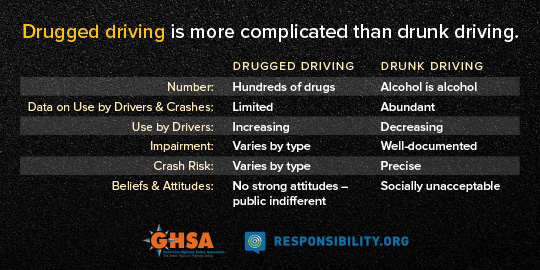Driving Under the Influence of Drugs, be they prescription, illegal, or marijuana, now accounts for 40 percent of driver fatalities, about the same as alcohol-related deaths, according to a new report from the Governors Highway Safety Association.
"A quadrupling in the use of prescription drugs since 1999, and legalization of marijuana use in some states are cited among the reasons drug use has become an increasing threat to roadway safety," writes of The Washington Post.

Credit: Governors Highway Safety Association (GHSA)
The number of dead drivers who tested positive for drugs has increased from 29 percent in 2005 to 39.9 percent in 2013, the report said, citing federal crash data.
The report from the GHSA, an "organization of state highway safety officers," draws on data from the Fatality Analysis Reporting System (FARS) supplied by the National Highway Traffic Safety Administration (NHTSA), a division of the U.S. Department of Transportation.
“We look to the federal government to take a leadership role in this issue similar to that of drunk driving and seat-belt use,” said Jonathan Adkins, executive director of the Governors Highway Safety Association.
"Marijuana is legal in some form in 23 states and the District of Columbia, while other states are considering legalization," writes Halsey III. "Driving under the influence of marijuana is illegal in all states."
“Every state must take steps to reduce drug-impaired driving, regardless of the legal status of marijuana,” Adkins said. “We encourage NHTSA to issue guidance on best practices to prevent marijuana-impaired driving.”
The report acknowledges that three other studies "differed somewhat in linking marijuana law changes to traffic fatalities," adds Ashley III.
One found that was there an increased marijuana presence in fatally injured drivers in only three of 14 states studied. Another focusing on Colorado said that marijuana-positive fatalities increased by about 4 percent. The third, in California, found no change after marijuana was decriminalized there in 2011.
Funding for the report was provided by the Foundation for Advancing Alcohol Responsibility (Responsibility.org).
FULL STORY: Drug use now rivals drunk driving as cause of fatal car crashes, study says

Planetizen Federal Action Tracker
A weekly monitor of how Trump’s orders and actions are impacting planners and planning in America.

Restaurant Patios Were a Pandemic Win — Why Were They so Hard to Keep?
Social distancing requirements and changes in travel patterns prompted cities to pilot new uses for street and sidewalk space. Then it got complicated.

Map: Where Senate Republicans Want to Sell Your Public Lands
For public land advocates, the Senate Republicans’ proposal to sell millions of acres of public land in the West is “the biggest fight of their careers.”

Orange County, Florida Adopts Largest US “Sprawl Repair” Code
The ‘Orange Code’ seeks to rectify decades of sprawl-inducing, car-oriented development.

Maui's Vacation Rental Debate Turns Ugly
Verbal attacks, misinformation campaigns and fistfights plague a high-stakes debate to convert thousands of vacation rentals into long-term housing.

San Francisco Suspends Traffic Calming Amidst Record Deaths
Citing “a challenging fiscal landscape,” the city will cease the program on the heels of 42 traffic deaths, including 24 pedestrians.
Urban Design for Planners 1: Software Tools
This six-course series explores essential urban design concepts using open source software and equips planners with the tools they need to participate fully in the urban design process.
Planning for Universal Design
Learn the tools for implementing Universal Design in planning regulations.
Heyer Gruel & Associates PA
JM Goldson LLC
Custer County Colorado
City of Camden Redevelopment Agency
City of Astoria
Transportation Research & Education Center (TREC) at Portland State University
Camden Redevelopment Agency
City of Claremont
Municipality of Princeton (NJ)



























